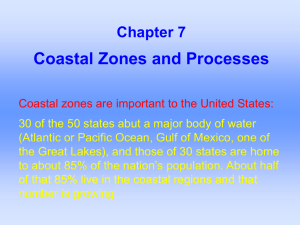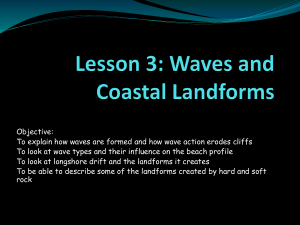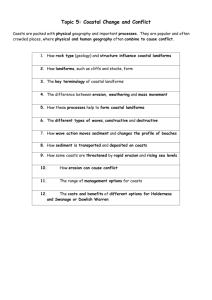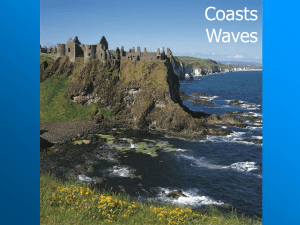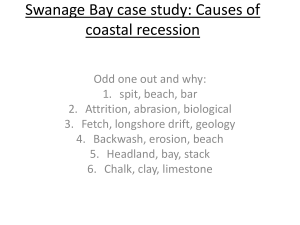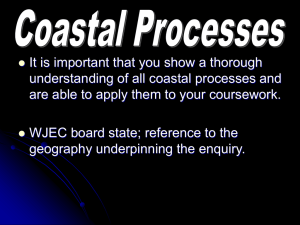Constructive Waves - Scoil Mhuire Geography
advertisement
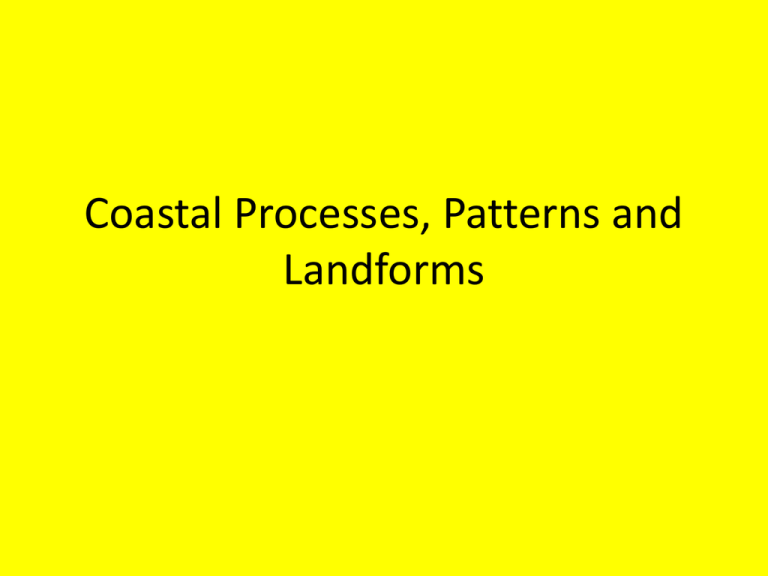
Coastal Processes, Patterns and Landforms Objectives • Discuss the processes of coastal erosion, transportation and deposition. • Understand the formation of coastal landforms and identify these on diagrams, maps and photographs. • Describe how human activities can affect natural coastal processes. • Discuss and describe the threats to the coastline and the methods used to protect it. • Explain how changes in sea levels affect coastal landforms. Activity • Mind map everything you remember about the coast! Waves • Two types of waves – Constructive and Destructive • The size of the wave is influenced by the fetch. The distance a wave has to travel before it reaches land. • When waves break water rushes up the beach called the swash. When the water goes back to the sea its called backwash. Destructive Waves • (i) the strength and speed of the wind – when the wind is fast, more energy is transferred and therefore the bigger the wave is produced. • (ii) the duration of the wind –when the wind remains strong over long periods- the longer the wind blows, the more energy is transferred to the wave • Destructive waves = erosion • The backwash digs into the land removing large quantities of rock, sand and earth. Destructive waves Weak swash Strong back wash Operate during storm conditions Erosion Constructive Waves • Powerful swash that can carry debris up the beach but have little energy left in the backwash to drag the debris away again. • Constructive waves = deposition Constructive waves Strong swash Weak backwash Make storm beaches Deposition Wave Refraction • Wave refraction is the bending of the waves. • The waves approaching the coast are straight. Friction with the sea bed causes part of the wave near the headland to slow down while the rest of the wave continues at the same speed. • The difference in speed makes the wave curve towards the headland. Coastal Erosion • Processes • Landforms (Essay Questions) • Identifying on OS and Aerial Photograph Sea Erosion http://www.bbc.co.uk/schools/gcsebitesiz e/geography/coasts/coastal_processes_re v3.shtml Can any one guess what the processes of sea erosion are? Hint: very similar to river erosion. Processes of Coastal Erosion 1) 2) 3) 4) 5) Hydraulic Action Compression Abrasion Attrition Solution Hydraulic Action • When strong waves crash against the coast they break rocks off the cliff face. Compression • Air Compression – The waves trap air in crack in the rocks. As the waves retreat the trapped air expand quickly and can crack the rock. Abrasion • This is erosion caused by small rocks carried in the sea water hitting against the coastline. p99 *Very similar to Hydraulic Action. Difference = water contains suspended rock material. Attrition • Erosion caused by the small stones hitting each other breaking themselves into smaller pieces. Solution • Salts in the sea water dissolve rock by chemical means. Chalk and limestone coasts are most easily eroded this way. Activity • Write the processes of erosion into your copies. Learn for homework. Examples of coastal landforms formed by erosion and deposition Landforms of Sea Erosion • Like rivers, the sea creates many features or landforms as a result of erosion. These include, 1. Cliffs and blowholes. 2. Bays and Headlands 3. Sea caves, sea arch, sea stack, sea stump Each of these will be a long answer essay. You will also be required to recognise these on a map/photo and diagram. The Sea/ The Coast • Cliff – close contour lines at the edge of the land near water. How are cliffs and wave-cut platforms formed? Cliffs and Wave-cut platforms The waves attack the base of the cliff through the processes of abrasion, compression, hydraulic action and attrition. Over time the cliff will be undercut and a wave-cut notch is formed. Eventually the cliff becomes unstable and collapses. Further cliff retreat will form a wavecut platform. Blowhole This is a passage that links the roof of a cave to the cliff top. Air trapped by waves erodes away the rock. This continues to create a tunnel called a blowhole. http://www.youtube.com/w atch?v=bWC_g2XfuQU Activity • Read the formation of a cliff in your groups. Hightlight the important information. • Homework: Write out a sample answer of a cliff and wavecut platform. Use F.E.E.D • Name the feature, example, explain and diagram. Sea Cave, Sea Arch, Sea Stack http://www.boardworks.co.uk/media/2132 de4b/ALevel%20Geography%20Sample/2 _9_stacks_stumps_animation.swf Sea Caves, Sea Archs, Sea Stacks • As the water smashes up against the headland rock, the erosion process begins. • Waves chisel away at the rock and over time a cave is formed. • The cave will give way and the water will drill its way on through the back of the cave, thus creating an arch. • Overtime the arch collapses to reveal one large stack of rock. This is the sea stack. Sea Stacks Sea Caves, Arches, Stacks and Stumps. • Stack little islands – green with blue outline. • Stumps underwater, smaller, grey. *Difficult to see an arch or cave. For Homework • Write out sample answers on Sea cave, arch and stacks using the FEED principal. • F = State the Feature • E = Explanation/Formation • E = Examples • D = Labelled Diagram Bays and Headlands http://www.youtube.com/watch?v=C_4DEkz9CCU • In your groups read how bays and headlands are formed. Highlight the important parts. For Homework • Write out sample answer on Cliffs and Sea Stacks using the FEED principal. • F = State the Feature • E = Explanation/Formation • E = Examples • D = Labelled Diagram Deposition Constructive Waves • Powerful swash that can carry debris up the beach but have little energy left in the backwash to drag the debris away again. • Constructive waves = deposition Before we talk about deposition we have to mention how the eroded material is carried along the coast. • What do you remember about longshore drift?? • Movement of material along the coast. • Occurs because the coastline is irregular and waves do not break parallel to the coast (wave refraction). • Swash moves material to the shore at an angle and the backwash pulls the sediment back out to sea at a right angle. http://www.youtube.com/watch?v=U9EhV a4MmEs Longshore Drift http://www.youtube.com/watch?v=rCpZYlPqn6E Activity: Read your book - page 55. Draw the diagram no.6 on page 55 of your book. Longshore Drift • http://www.youtube.com/watch?v=U9EhVa4 MmEs&feature=related • Activity: Using the above information and notes in your book. Summarise longshore drift into your copies Landforms of coastal deposition 1) Beaches 2) Sand Spits, Sand Bar and Lagoon 3) Tombolos Beaches form in sheltered environments, such as bays. When the swash is stronger than the backwash, deposition occurs. Beach • Can be seen on an OS map – coloured yellow at the coast • Beaches have other landforms such as Berms, Cusps and Runnels and Ridges. • Berms: are long steps or terraces which form on shingle beaches when constructive waves push beach sediment into long low ridges. They mark the junction between the backshore and foreshore. • Cusps: Crescent shaped hollows formed where shingle changes to sand. Generally occur on pebble beaches • Runnels and Ridges: Runnels are wide depressions in the sand of the foreshore. Ridges are gentle rises in it. Formed by the action of constructive waves. Activity • Read the notes in book about the formation of a beach. • Complete a sample answer into your copies using F.E.E.D and remember at least 13 SRPS. Sand Spit • A long deposit of sand attached to the land at one end. • Example: Portmarnock and North Bull Island in Dublin. • Created when the process of longshore drift is interrupted in some way either by a change in the shape of the coast or by human activity such as building a sea wall . • They are commonly found attached to the headland. Sand Bar and Lagoon • When a spit grows and reaches out to the other side the spit is called a sand bar. • If it cuts water off from the sea a lake is formed called a lagoon. Tombolo • When a spit grows out into the ocean and joins to an island its called a tombolo. Homework • Write out the sample answer for sea spit, baymouth bar, lagoon and tombolo. • Use the F.E.E.D principle and remember 15 SRPS! Human Interaction with the Coast • • • • • • • • • Fences Mats Beach nourishment Groynes Sea walls Rock armour Revetments Breakwaters Gabions Coastal Defence • When managing the coastline there are two main options: 1. HARD This is where man made coastal defence structures are used to reflect large amounts of wave energy and hence protect the coastline. Sea Walls, Rock Armour, Breakwaters and Gambions SOFT ENGINEERING 2.This is where beaches or naturally formed materials are used to control / re-direct erosion processes. Designed to encourage beaches and dunes to form or get bigger Fences in sand dunes, mats, Beach nourishment and groynes HARD COASTAL PROTECTION METHODS 1. Sea Wall Sea walls Re-Curved Sea Wall • - concrete wall which is curved on the underside to deflect the power of the waves • these can be very expensive and the deflected waves can scour material at the base of the wall causing them to become undermined these are however a very effective means of preventing erosion and they reflect rather than absorb wave energy. 2. ROCK ARMOUR Boulders Rock Armour • large boulders on the beach absorb wave energy and break the power of the waves • - although movement of the boulders is expensive this can be a much cheaper method than some other solutions • - the boulders can however be undermined easily by waves washing away sand and shingle beneath them. They also can be quite ugly, changing the appearance of a coastline. 4. Gabions Gabions • these cages of boulders are built into cliff faces to protect the cliff from the force of the waves; - they are cheaper than sea walls and can be very effective where severe erosion is a problem - they are however visually intrusive 5. Revetments Revetments • these wooden structures break the force of waves and beach material builds up behind them - they are cheap and effective at breaking waves - as well as being visually intrusive however they do need replacing more frequently than most other defence methods. Breakwaters • Concrete walls built some distance offshore to reduce the force of the waves. Soft Engineering Techniques Soft Engineering Techniques • Soft engineering includes beach replenishment in which beach material is added to provide a "natural solution". Environmentally this is a preferred option as it maintains the beauty of the landscape and avoids visual intrusion, however it can be expensive to maintain as longshore drift continues to move beach material down the coast and therefore regular replenishment is required. • Sand Dunes and salt marshes can also be encouraged to act as natural barriers to the waves. Fences and Mats • Encourage build up of wind blown sand in dunes • Mats are placed in front of dunes. They trap sand and encourage plant growth Groynes Groynes 3. Groynes • these structures (usually either wooden or steel) are designed to top longshore drift and therefore act to build up and anchor beach material, protecting the base of cliffs. Groynes • they are effective at reducing erosion in the area they are constructed in by causing significant build up of beach material - groynes may however starve areas further down the coast of material by stopping longshore drift, resulting in an increase in erosion in these areas Case Study of Human Interaction • Read the handout of human interaction in Courtown north beach Co. Wexford. Isostatic and Eustatic Processes • Isostatic processes involve adjustments to the balance between land and the sea. • The balance may change over time. Did you know that in some coastal areas beaches and cliffs can be seen above the present sea level. Two processes occur which lead to changes in land and sea level Keywords • • • • Eustatic/ eustacy Submerged coastlines Isostatic/ isostacy Emerged coastlines Eustatic changes/ Eustacy • Sea levels rise or fall • During an ice age sea level drops because rain and river water is locked away in the ice sheets and do not reach the sea. • When the ice melts large volumes of meltwater flow into the sea and cause a global rise in sea levels. • Submerged coastlines when the coastal areas are drowned by the water. Isostatic Change/ Isostacy • Land rises or falls • The earth’s crust floats on the liquid mantle. The weight of huge ice sheets on the land can cause the earth’s crust to push into the mantle. • This is like a plastic duck floating in water. When you push down on the duck the duck will go underneath the water. • When the ice melted the weight was removed from the earth and the crust returns to its original level raising the land out of the sea. • These are all local actions. The local change in sea level is called isostatic sea level chanage. • Coastal area that are raised from the sea by isostacy are known as emerged coastlines. Landforms of Submergence • • • • Rias Fjords Fjards – submerged glacial lowlands Dalmatian Coasts – submerged valleys running parallel to the coast Rias Rias are submerged river valleys. The lowest part of the river’s course and the floodplains alongside the river may be completely drowned, but the higher land remains exposed, e.g. Kingsbridge Estuary, Devon • In cross section the ria has relatively shallow water becoming increasingly deep towards the centre. The exposed valley sides are quite gently sloping. • In long section rias are quite even with a smooth profile and water of uniform depth. • In plan view they tend to be winding, reflecting the original route of the river and its valley. Fjords Fjords are submerged glacial valleys. They have steep, cliff-like valley sides and the water is uniformly deep (often 1000m in depth). These were formed when glaciers eroded below sea-level. When the ice melted the valleys were flooded, e.g. Milford Sound fjord, New Zealand • The u-shaped cross-section reflects the original shape of the glacial valley. • Unlike rias, fjords are not deepest at their mouths, but have a shallow section at the seaward end known as the threshold. • Fjords have much straighter routes, due to the erosive power of the glacier. Landforms of Emergence • Raised Beaches • Abandoned Coastlines Raised Beaches Raised beaches, e.g. Little Gruinard, Ullapool are areas of former wave-cut platforms and their beaches which are left at a higher level than the present coastline. Abandoned cliffs, caves and stacks can also be found. Exam Questions • • • • • Have to recognise all landforms on OS maps Landforms of erosion Landforms of deposition Human interaction with the coast Changes in sea level End of Chapter Assessment • Traffic light the learning objectives at the start of the chapter • Make sure all essay questions are up to date.

